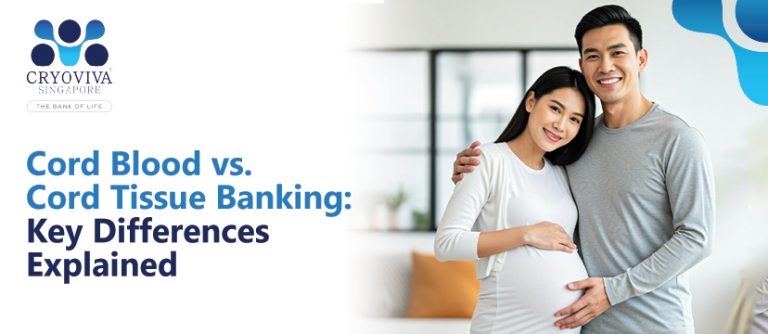Blog
Cord Blood vs Cord Tissue: Key Differences Explained

There are many ways to preserve stem cells for a baby’s future health; however, two of the most common methods are:
- Cord blood banking
- Cord tissue banking
The goal of these methods is the same: to collect beneficial stem cells from the baby’s umbilical cord right after birth for future medical use. However, the key difference lies in what part of the cord the stem cells come from and how they can be used later.
What is Cord Blood Banking
(Collection of stem cells from Cord Blood)
Cord blood banking is when healthcare professionals collect and preserve the blood left in a baby’s umbilical cord shortly after childbirth. This cord blood has special stem cells that have the potential to fight serious diseases in the future.
What is Cord Blood
It is the blood left in the umbilical cord and placenta post-delivery. After the baby’s birth, the umbilical cord is clamped and cut, leaving an average of 80–120 milliliters, or around 1/3 of a cup to 1/2 of a cup, of blood inside. A professional from the private cord blood bank carefully draws this blood from the cord into a collection bag using a surgical needle.
What is Cord Tissue Banking
(Collection of stem cells from Cord Tissue or Wharton’s jelly)
Cord blood banking is the process of storing a newborn’s umbilical cord tissue (or Wharton’s jelly) or the components it contains and cryogenically freezing them.
Right after the child’s birth, the umbilical cord is clamped and cut, and a section of the cord (usually a piece measuring four inches in length) can then be stored.
What is Cord Tissue
Cord tissue, also known as Wharton’s jelly. It is a thick, gelatinous substance that surrounds the vessels of the umbilical cord. It contains a range of crucial cell types, such as mesenchymal stem cells (MSCs), fibroblasts, and macrophages, that can be stored and used for future therapy.
Cord blood banking has become mostly standardized over the years; however, cord tissue banking is still an evolving field, and industry standards are still being developed.
Cord Blood vs Cord Tissue Banking: The Difference
Here is the comprehensive cord blood and cord tissue banking comparison:
|
Key Point |
Cord Blood Banking |
Cord Tissue Banking |
|
Definition |
Storing blood from the baby’s umbilical cord |
Storing cord tissue from the baby’s umbilical cord |
|
Type of stem cells |
Hematopoietic Stem Cells |
Mesenchymal Stem Cells |
|
Can become or help make |
Make blood & immune cells |
Can become bone, muscle, nerves, etc. |
|
Used to treat |
Potential of treating blood disorders like leukemia, anemia, and immune problems |
Studying the repair of tissues such as bone, cartilage, and nerves |
|
Matching required |
Yes, matching is required between the donor and recipient for a successful transplant |
No matching required for the same person or close family member |
|
FDA Approval |
Many treatments are FDA-approved |
Most therapies are still in research and the early clinical trials phase |
|
Time of collection |
Right after the delivery of cord blood |
Right after delivery from the cord tissue |
|
Storage Time |
Up to 23.5 years |
Up to 23.5 years |
|
Number of treatments |
Generally, one treatment per stored sample |
Cells can multiply, so multiple treatments are possible |
Cord Blood vs Cord Tissue: Which is Better
Cord Blood
- It contains hematopoietic stem cells, which have the potential to make blood and immune cells.
- It is proven to address 80+ medical conditions, especially blood and immune disorders.
- It requires a match between the donor and patient for the possible treatment.
- Many treatments are FDA-approved. It allows only one treatment per storage.
Cord Tissue
- Mesenchymal stem cells carry the potential to become bone, muscle, or nerve.
- Many treatments are still in their early phases, but have the possibility of future regenerative therapies.
- Usually do not need a matching if the recipient is a close family member.
- Cord tissue stem cells can multiply more easily; hence, multiple treatments are possible per storage.
Which to Choose?
Both have their own unique benefits and are valuable for different medical reasons. Hence, if possible, consider both. Because cord blood has proven medical treatment, while cord tissue has immense potential for regenerative medicine (focus on the creation of tissues to replace or restore damaged tissues).
Conclusion
It’s true that no one knows what the future holds; however, storing stem cells with a reliable private bank like Cryoviva Singapore helps many families to be prepared for any medical difficulties ahead.
We offer safe, accredited cord blood and cord tissue banking services with advanced technology. Our team ensures quick and hygienic sample handling after delivery. By preparing early and keeping a cord collection kit handy at delivery, you can secure your baby’s valuable stem cells for a disease-free future. Contact Cryoviva today to learn more and stay prepared.
FAQ's
Cord Blood Stores Hematopoietic Stem Cells are used mainly for blood diseases, while cord tissue contains mesenchymal stem cells that have the potential to repair bones, muscles, and nerves.
Cord Blood banking can help address 80-plus diseases, especially those related to the blood and immune system.
Banking both Cord Blood and tissue is worth it, as they offer the options for potential treatments against any disease.


